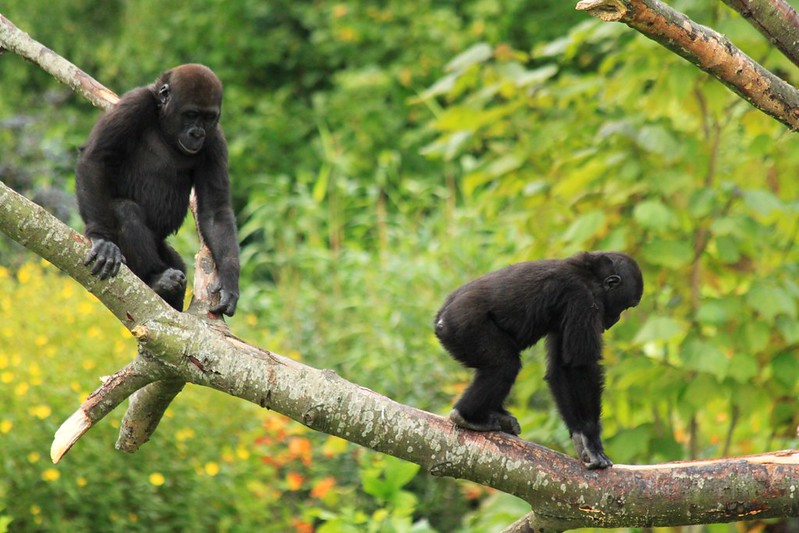Types of Gorillas
Types of Gorillas: Globally, there exist two species of gorillas: the Western gorilla and the Eastern gorilla, as delineated below. Prior to delving into the specifics of gorilla classifications, allow me to provide a concise overview of what constitutes a gorilla.
What defines a Gorilla?
Gorillas are typically gentle giants residing in the tropical regions of the African continent. They exhibit various human-like emotions and behaviors, such as melancholy and laughter. Notably, they share approximately 98% of their DNA with humans, rendering them similar to chimpanzees, our closest living relatives.
Features of Gorillas
Gorillas are the largest of the great apes, characterized by robust bodies often including broad chests and powerful shoulders. They possess notably hairy features with small eyes, and their limbs have hands that closely resemble those of humans. They congregate in familial units of from 5 to 15 members, however some may consist of as many as 40 individuals within a single family. Each family is governed by a male adult known as the ‘silverback,‘ who shapes the family’s social dynamics through his relationships with the females. Female gorillas attain sexual maturity at approximately 7 to 8 years, although males may require a longer duration. They typically give birth to a single offspring, although instances of twins have been documented, occurring every 4 to 6 years.

Types of Gorillas
1 The Eastern gorilla species
The Eastern gorilla species consists of two sub-species: the mountain gorillas, with an estimated population of over 1,063 as per a 2018 survey conducted by the Greater Virunga Trans-boundary Collaboration and the Ministry of Tourism, Wildlife, and Antiquities of Uganda, and the eastern lowland gorillas, whose numbers have reportedly declined by nearly 50% from a mid-1990s population of 17,000, according to scientific estimates.
They predominantly inhabit the rainforests of Nigeria and Cameroon. When bipedal, they can attain heights ranging from 4 to 5.5 feet and can weigh up to 450 pounds. The habitat of this subspecies of gorillas is estimated to span approximately 3,000 square miles, which is currently densely populated by humans who, regrettably, clear this natural environment for agricultural pursuits, livestock rearing, and timber extraction. The diminutive population of Cross River gorillas is currently attributed to the rampant poaching occurring in this region. Regrettably, the Cross River Gorilla is currently classified as one of the most endangered species. The governments of Nigeria and Cameroon, in collaboration with WWF and other animal conservation organizations, are diligently implementing steps to save this natural environment, as it spans both nations. Ongoing sensitization and awareness initiatives in these two countries aim to educate local populations residing near these reserves about the benefits of maintaining and protecting this subspecies.
The Mountain Gorillas
This subspecies predominantly inhabits thickly forested regions and thrives at elevations ranging from 8,000 to 13,000 feet. They are exclusively located in three countries worldwide: the Bwindi Impenetrable Forest in Uganda, and the Virunga Mountains, which extend into Uganda’s Mgahinga National Park, Rwanda’s Volcanoes National Park, and Virunga National Park in the Democratic Republic of Congo. When bipedal, these gorillas could reach a height of 4 to 5.5 feet, and an adult gorilla may weigh up to 480 pounds.
Mountain gorillas possess a substantial amount of fur and a dense coat, an adaptive trait that allows them to thrive in the cooler regions of forested settings. As humans encroach upon their native habitat, these mountain gorillas are compelled to retreat further into the forest, where the temperatures and climatic conditions are typically severe. The subspecies isVirunga National Park currently classified as critically endangered, with little over 1,000 mountain gorillas globally, an increase from 850 in the 1990s. Gratitude is extended to the commendable conservation efforts undertaken by the governments of Uganda, Rwanda, and the Democratic Republic of Congo, which have resulted in the recent increase in mountain gorilla populations.
The Western Gorilla Species
The western gorilla species consists of two subspecies: the Cross River gorillas, estimated to number between 200 and 300, and the western lowland gorillas, with a population exceeding 100,000. This is, in fact, the most prevalent and renowned subspecies of gorillas globally.
This subspecies is located in the Democratic Republic of Congo, residing in the lower regions of the eastern tropical rainforests. Human encroachment has diminished their habitat from an initial expanse of 8,000 square miles to a mere 5,500 square miles, constituting around 13% of the original habitat. The eastern lowland gorilla possesses a stocky physique, abbreviated snout, and substantial hands. When bipedal, they could attain a height ranging from 4 to 5.5 feet, with an average body weight of 450 pounds.
This gorilla subspecies is the most prevalent and possesses the biggest population of individuals. These species are located in the Congo and Cameroon regions, inhabiting various environments, including rainforests and wetlands. They are physically smaller than other gorilla subspecies, characterized by broader skulls, diminutive ears, brown-grey pelage, and reddish-brown chests. Their precise numbers are unknown due to a portion residing deep within the lush forests of their surroundings. Nevertheless, they are classified as an endangered species, with poaching and habitat encroachment posing the most significant challenges to their survival.
Comparative Analysis of Eastern and Western Gorillas
Both species of gorillas inhabit the tropical and subtropical regions of Africa; yet, one may inquire about the primary distinction between these two gorilla species. The primary distinction between these two is the auditory signals employed during communication and the dimensions of their nasal structures. Moreover, Eastern gorillas typically exhibit a larger size than their Western counterparts.
Challenges impacting the gorilla population Globally, the most significant threat faced by gorilla species is the degradation of their natural habitat caused by human activities, including infrastructure development, agriculture, and land clearing for livestock grazing, all of which contribute to deforestation. Furthermore, the hunting of forest giants for their meat and for illicit trading on the black market
